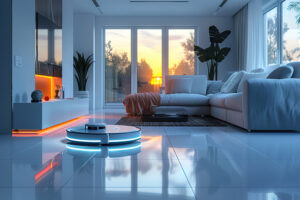
In the bustling city-state of Singapore, where innovation and efficiency are paramount, the integration of smart technology in living room design has become increasingly prevalent. This evolution is about adopting the latest gadgets and transforming living spaces into intelligent environments that enhance comfort, convenience, and sustainability. In this article, we will delve into the trends, benefits, and practical aspects of incorporating smart technology into living room design in Singapore.
The Rise of Smart Technology in Home Design
Singapore’s rapid technological advancements and urban lifestyle demand sophisticated living solutions. Smart technology integration in living rooms aligns perfectly with these needs, offering a seamless blend of aesthetics and functionality. This trend reflects a broader movement towards smart homes, where interconnected devices work together to create a cohesive, intelligent living environment.
Benefits of Smart Technology Integration
Here are some benefits of integrating smart technology in living room design:
Enhanced Comfort and Convenience
Smart living rooms offer unparalleled comfort and convenience. Voice-controlled devices eliminate the need for physical remotes, while automated systems ensure optimal living conditions with minimal effort. In a fast-paced city like Singapore, where residents value efficiency, these features significantly enhance daily living.
Energy Efficiency and Sustainability
Smart technology promotes energy conservation, aligning with Singapore’s commitment to sustainability. Automated lighting and climate control systems reduce unnecessary energy consumption by adjusting settings based on real-time usage and occupancy. This not only lowers utility bills but also contributes to environmental conservation efforts.
Improved Security
Smart living room designs incorporate advanced security features, such as smart locks, cameras, and motion sensors. These devices provide real-time monitoring and alerts, enhancing the safety of homes. Integration with broader smart home systems allows for centralized control, giving homeowners peace of mind whether they are at home or away.
Personalization and Adaptability
Smart technology allows for highly personalized living experiences. From customizable lighting scenes to adaptive climate control, these systems cater to individual preferences and routines. In a diverse society like Singapore, where personal tastes vary widely, this adaptability is particularly valuable
Key Elements of Smart Living Room Design
10 key elements of a smart living room design includes:
1. Smart Lighting Systems
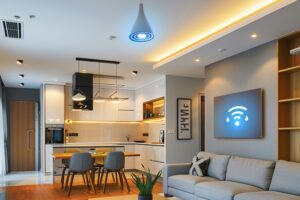
Integrating smart lighting systems into your living room allows for control over the ambiance and functionality of the space. Smart lighting systems also contribute to energy efficiency by allowing you to turn off lights remotely and set them to operate only when needed, thus reducing electricity consumption and costs.
2. Smart Thermostats
Smart thermostats, such as the Nest Learning Thermostat, offers a sophisticated way to manage your living room’s climate. These devices learn your preferences and adjust the temperature automatically to ensure optimal comfort. Smart thermostats can be particularly beneficial, allowing for efficient cooling without unnecessary energy waste. You can also do remote access through your smartphone apps means you can control the temperature even when you’re not at home.
3.Voice-Activated Assistants
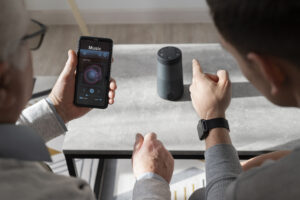
Voice-activated assistants like Amazon Alexa, Google Home, and Apple Siri have become central to modern smart homes. In the living room design, these devices act as a hub for controlling other smart technologies, playing music, setting reminders, and answering queries, all hands-free. By integrating a voice-activated assistant, you can manage your smart devices more effortlessly, streamline your daily routines, and even entertain guests with interactive functionalities.
4. Smart Entertainment Systems
Transforming your living room into an entertainment powerhouse is easy with smart TVs, streaming devices, and connected sound systems. Devices like the Apple TV, Google Chromecast, and high-quality soundbars provide seamless access to a vast array of , from streaming services to gaming platforms. These systems can be controlled via apps or voice commands, simplifying the user experience and eliminating the need for multiple remotes.
5. Motorized Blinds and Curtains
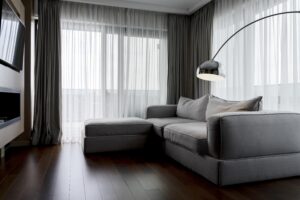
Motorized blinds and curtains offer a blend of luxury and practicality, allowing you to control natural light and privacy in your living room with ease. These systems can be operated via remote control, smartphone apps, or voice commands, providing the convenience of adjusting your window coverings without getting up. Additionally, motorized blinds and curtains can be scheduled to open and close at specific times, enhancing energy efficiency by reducing heat gain during the day and retaining warmth at night.
6. Smart Plugs and Outlets
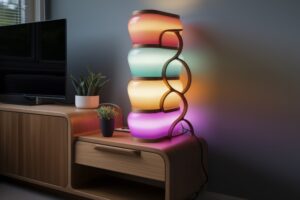
Smart plugs and outlets are versatile additions to any smart living room, enabling you to transform ordinary devices into smart ones. By plugging lamps, fans, or other electronics into a smart outlet, you can control them remotely via an app or voice commands. Smart plugs also offer the convenience of turning devices on or off from anywhere, adding an extra layer of control and efficiency to your living space.
7. Home Security Systems
Incorporating smart home security systems into your living room design enhances both safety and peace of mind. Smart cameras, motion sensors, and smart locks allow you to monitor and secure your home in real-time. These devices send alerts to your smartphone if unusual activity is detected, and many systems allow you to view live feeds or recorded footage remotely. Smart locks enable you to control access to your home, providing secure entry options without traditional keys.
8. Smart Furniture
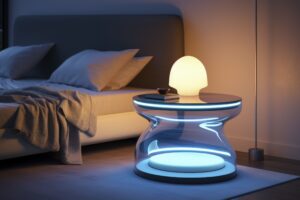
Smart furniture combines comfort and technology to maximize functionality in the living room. Examples include motorized recliners, adjustable-height coffee tables, and sofas with built-in charging stations. These pieces can often be controlled via apps or voice commands, offering personalized comfort settings and convenient access to power for your devices. By integrating intelligent furniture, you create a versatile and efficient living area tailored to modern lifestyles.
9. Smart Speakers
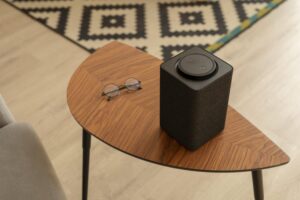
Smart speakers such as Sonos and Bose have redefined audio experiences in the living room. These devices deliver high-quality sound for music, podcasts, and other audio content while also serving as hubs for controlling other smart devices. With voice-activated capabilities, smart speakers can manage your lighting, climate control, and entertainment systems, streamlining the user experience.
10. Multi-Room Audio Systems
Multi-room audio systems allow you to enjoy synchronized music playback throughout your home, including the living room. Systems like Sonos enable you to control audio in different rooms from a single app, ensuring seamless transitions as you move around your home. This integration is perfect for entertaining guests or enjoying a consistent auditory environment. Multi-room audio systems can be tailored to individual preferences, providing personalized sound experiences in each room.
Conclusion
The integration of smart technology in living room design in Singapore is not just a trend but a significant shift towards more efficient, comfortable, and sustainable living. By incorporating advanced lighting, climate control, entertainment systems, and intelligent furniture, homeowners can create spaces that adapt to their needs and enhance their quality of life. As technology continues to evolve, the possibilities for smart living rooms will only expand, making it an exciting frontier in interior design.
Ready to turn your living room dream into reality? Book an appointment with E³.SPACE, and let us bring your vision to life.

